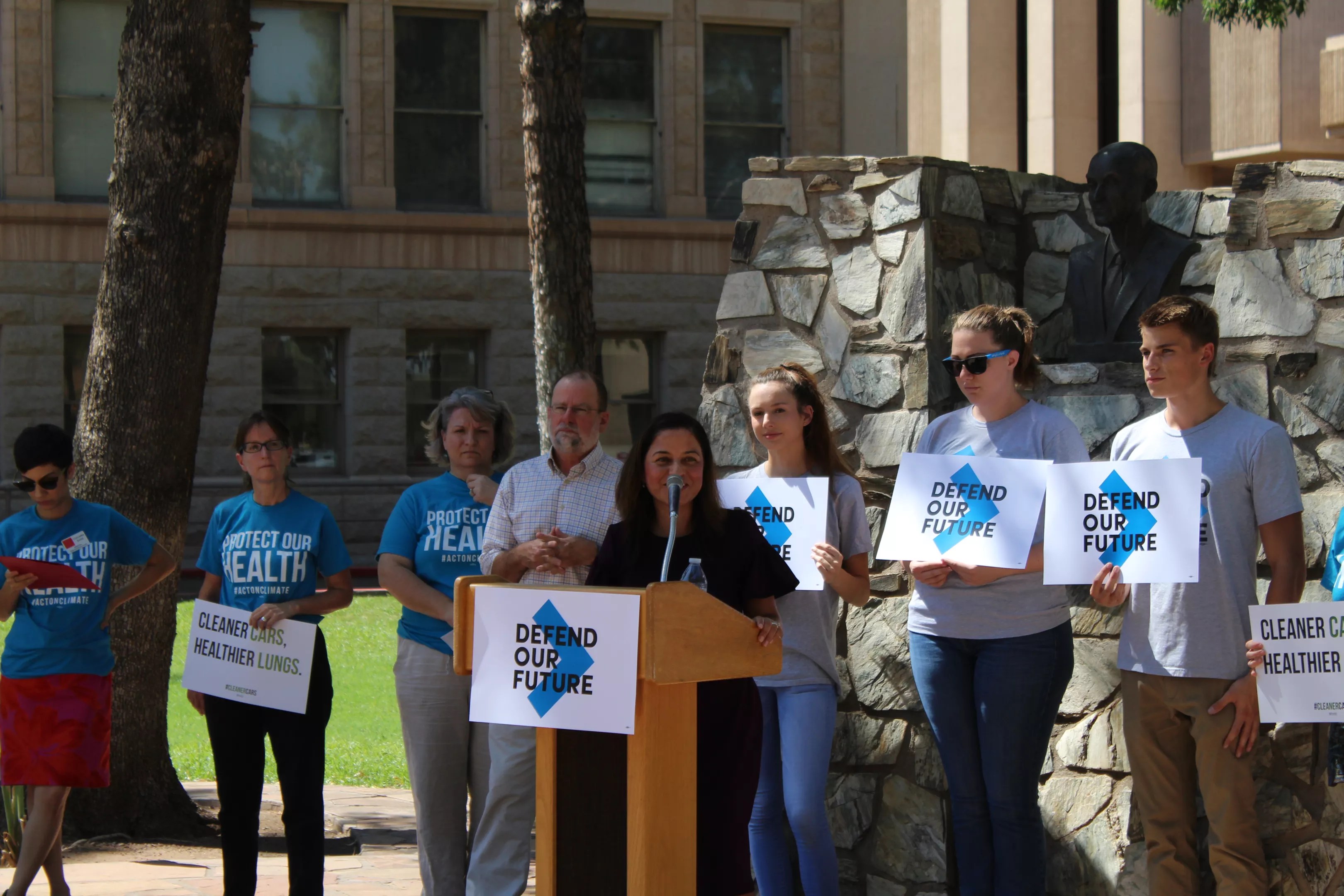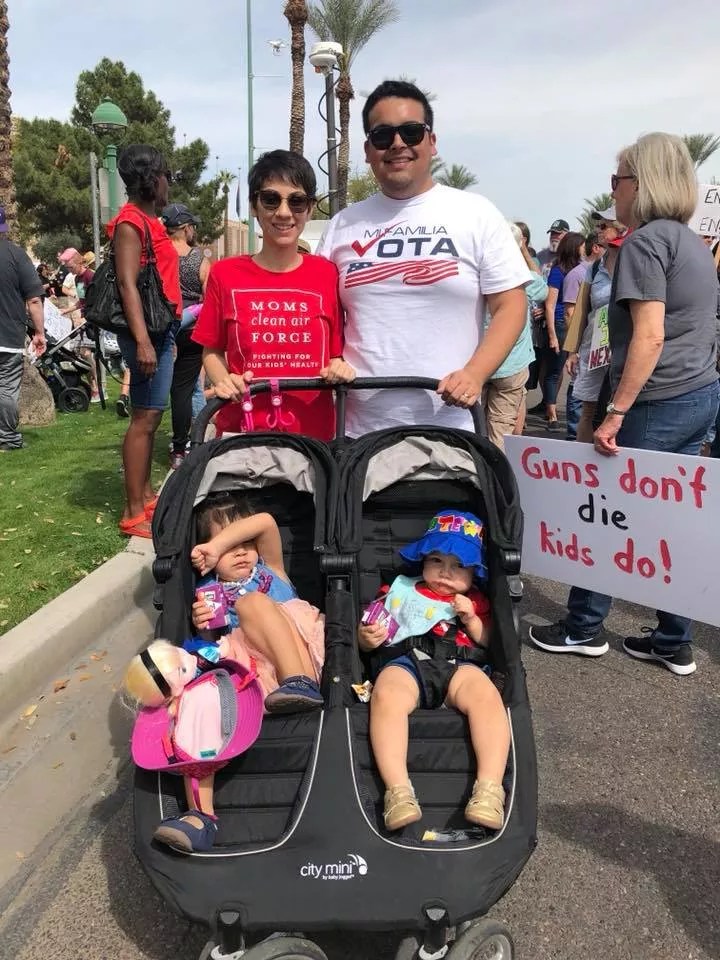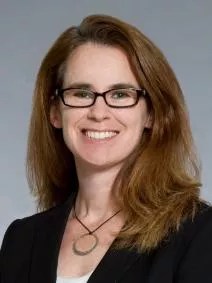
Elizabeth Whitman/Phoenix New Times

Audio By Carbonatix
When Columba Sainz and her husband moved from Tucson to Phoenix in January, they took their two young daughters to the park across the street to play every day for up to two hours. About four months later, their elder child, who is 3 years old and also named Columba, started wheezing at night.
“We kind of knew about what was going on,” Sainz said, referring to air pollution in Phoenix. They live in the Central Park area, a neighborhood with two bus terminals and ongoing construction. What she and her husband didn’t expect was for the pollution to affect their daughter, and so quickly.
Sainz, the Arizona field consultant for Moms Clean Air Force, a national nonprofit that works to fight air pollution, spoke to Phoenix New Times after speaking at a press conference Wednesday hosted by the climate advocacy group Defend Our Future. At the briefing, a collection of environmental and public health advocates warned of the potential health effects of reduced fuel-emissions standards, which were proposed in early August by the Trump administration. These new, lower standards would cut into efforts to reduce air pollution in the Phoenix area, hitting children, people with chronic respiratory problems, and communities of color particularly hard, they said.

Every member of the Sainz family has suffered from respiratory problems since moving to Phoenix in January.
Courtesy of Columba Sainz
“It’s a direct attack on the health of our children,” Sainz said.
Eventually, her husband, Eduardo, took Columba to the doctor, who diagnosed her with a sinus infection. Then, it turned out, their younger daughter had sinusitis too. Recently, Eduardo was prescribed an inhaler. Sainz coughed slightly as she spoke. “The doctors said it was mostly caused by pollution,” she said, although they couldn’t ascertain exactly to what extent these problems were due to pollution rather than to other causes.
Others at the media briefing sought to send a similar message directly to voters, all but begging them to take action opposing the proposed rule and to elect leaders in November who would work to protect the environment. The event’s organizer, Defend Our Future, is a nonprofit organization aimed at addressing climate change and advancing clean energy policies.
The rule proposed by the Environmental Protection Agency and the National Highway Traffic Safety Administration would roll back standards negotiated under the Obama administration. Those mandates, which are still in effect, require automakers to gradually increase the average fuel efficiency of their new fleets, starting in 2012. By 2025, new cars, trucks, and SUVs have to fetch an average of about 50 miles per gallon.
The Trump administration is seeking to halt that progression with the 2021 model year. Reported estimates of the average fuel efficiency at that point vary, from around 37 miles per gallon to 41 miles per gallon. In the 2016 model year, the efficiency of new cars and trucks reached 24.7 miles per gallon. The current average fuel economy of all vehicles on the road is 21 miles per gallon, according to the Union of Concerned Scientists.
“We’re moving backwards,” Arizona State Representative Isela Blanc said, standing at a wooden podium in the Rose Garden of the State Capitol during Wednesday’s press conference.
The state needs to elect leaders, Republican or Democrat, who can stand up for the environment, she added. Blanc gestured at the dozen members of Defend Our Future, many of them college students, fanned out behind her, clutching placards with messages including “Cleaner Cars, Healthier Lungs.”
“I look to all you young people to help us,” Blanc said.
Will Humble, the executive director of the Arizona Public Health Association, a nonprofit that works to protect the health of people and their communities, emphasized that per the federal rule-making process, the Trump administration’s proposal is open for public comment.
The Arizona Department of Environmental Quality has opposed rolling back these requirements, which the EPA and NHTSA began publicly considering in March 2017.
“We urge EPA to retain these standards,” ADEQ director Timothy Franquist wrote in a letter of comment to the EPA in October 2017. “If the new … standards are revoked, ADEQ would not be able to achieve equivalent emission reductions simply by further regulating stationary sources.”
However, the ADEQ said it has not carried out projections analyzing the difference in ozone levels from vehicle emissions under the current rules and under the proposed ones.
In Maricopa County, cars, trucks and SUVs produce 42 percent of the air pollution, more than any other source, and between 2017 and 2022, Arizona is expected to gain 1 million additional cars, Franquist wrote. He described cutting emissions from vehicles as “a vital control measure” and “a key part” of the strategy to comply with ozone standards set by the Clean Air Act.
Cars and other petroleum-burning motor vehicles spew nitrogen oxides, which then react in the sunlight – of which Phoenix has more than plenty – with gases known as volatile organic compounds. These “VOCs” come from tailpipes as well as chemical manufacturers, refineries, factories, and consumer products like paint. Together, nitrogen oxides and VOCs produce ozone, the main ingredient in smog. Ozone levels in Phoenix have run afoul of these federal limits 50 days so far this year, preliminary data from the ADEQ show. That’s more than the number of days Phoenix air violated federal standards in all of 2017 (42 days) and 2016 (29 days).
The department says that overall air quality in Maricopa County has actually improved in the last two decades. On average, ozone pollution has fallen from just below 85 parts per billion in 1996 to just over 70 parts per billion in 2016. Despite this progress, Arizona is chasing a moving target. The EPA has continued to lower federal standards for ozone pollution; most recently, in 2015, it revised the requirement from 75 to 70 parts per billion.
If Obama-era emissions standards are maintained, Franquist wrote, cars and trucks will use less fuel overall.
“Collectively, this reduction in fuel use and emissions will result in an improvement to air quality throughout the state, particularly for regions currently grappling with air quality issues caused, in part, by vehicle emissions,” he concluded.
Others are also concerned that freezing those standards would hinder Phoenix’s ability to improve its air quality. Sandy Bahr, director of the Grand Canyon chapter of the Sierra Club, said at the press conference that the proposed rollback was “a stealth tax” on health. If automobiles ceased to help reduce pollution, other industries would have to pick up the slack by curbing their own emissions, taking an economic toll, Bahr said.

Ashley Langer
Ashley Langer, an economist at the University of Arizona, backed up that assertion.
“If cars pollute more, then [Phoenix] needs to find somewhere else to reduce pollution,” Langer said.
For example, in order to reduce their emissions, factories might not be allowed to run 24 hours a day. “It means you can now run two shifts instead of three, and that means less output, and that means less profit,” Langer said.
Arizona could also end up imposing other types of environmental regulations on manufacturers in order to comply with the federal Clean Air Act, said Nick Kuminoff, an economics professor at Arizona State University. To get a sense of these demands, Arizona need look no farther than California.
“California has regulations on everything from when farmers can burn rice straw to the chemical content of coatings for screen doors,” Kuminoff said. “One possible regulatory response in Maricopa County would be to enact these California-like regulations.”
Research by the economist Reed Walker at the University of California, Berkeley suggests that new environmental regulations take a toll on workers in that newly regulated industry, most often because they’re forced to find jobs elsewhere. In a study published in the Quarterly Journal of Economics in 2013, Walker looked at the effects of the 1990 Clean Air Act Amendment on workers in the manufacturing and electric or gas industries. He found that the earnings of an average worker in a plant declined by 20 percent after regulations kicked in. “These earnings declines are persistent and only begin to recover some five years after the policy,” he wrote.
Other ways to cut down on pollutants in Phoenix could be to expand requirements for the use of reformulated gasoline, which is more expensive but produces less ozone, beyond the summer months, Kuminoff suggested. The state could also impose stricter emissions testing for older vehicles. Under both these options, Phoenician drivers would pick up the tab.
Nevertheless, not even the original standards are ideal in economists’ eyes, Langer said. A gas tax would be far more effective in discouraging people from driving or motivating them to buy more efficient cars, she said, but such a tax is “politically toxic.” So the government instead tries to regulate fuel-emission standards. “It’s the policy we’ve chosen to use because we can’t implement the one that would be better,” she said.
The current rules have negative consequences of their own. Cars will cost more for consumers, because manufacturers will have to create incentives to persuade more customers to buy a more efficient car that they might not otherwise prefer, Langer said. And, people can be expected to drive more, an outcome known as the rebound effect. More driving means more accidents and more congestion, Langer said, although the rebound effect would not lead to an increase in total emissions, if cars are more efficient.
As the debate goes on, the problem of pollution and resultant health issues stubbornly remains. Inhaling ozone can cause a spate of health issues, especially for children, the elderly, and people with lung disease. Children are uniquely vulnerable to ozone pollution, because their lungs are young and still developing, and they are more likely to be outside when ozone levels are high.
Asthma rates are worse in Arizona than throughout the U.S. overall. In 2014, 9.6 percent of adult Arizonans had asthma and 10.9 percent of children did; the national rates that year were 8.9 percent and 9.2 percent, respectively. Overall, an estimated 615,000 Arizonans have asthma, which kills 100 people in the state every year, according to a report by the American Lung Association in Arizona.
Pollution also increases the risk of heart disease, Michael Yost, a professor at the University of Washington’s School of Public Health, wrote in a recent opinion piece in the Seattle Times. “If this plan goes ahead, the changes will directly affect the air you breathe,” Yost wrote, referring to the Trump administration’s proposal.
Based on what doctors have told her, Columba Sainz believes that Phoenix’s pollution is causing, or at least triggering, her family’s breathing problems. She hopes that at some point, they will be able to live in a cleaner neighborhood. She has a third child on the way, and she fears the air will be especially harmful to the new baby.
But if they do move within the Phoenix area, it won’t be possible to completely escape the polluted air. “My husband asked the doctor, ‘Should we move?'” Sainz said. “He said, ‘Well, wherever you go, it’s going to be as bad as it is here.'”